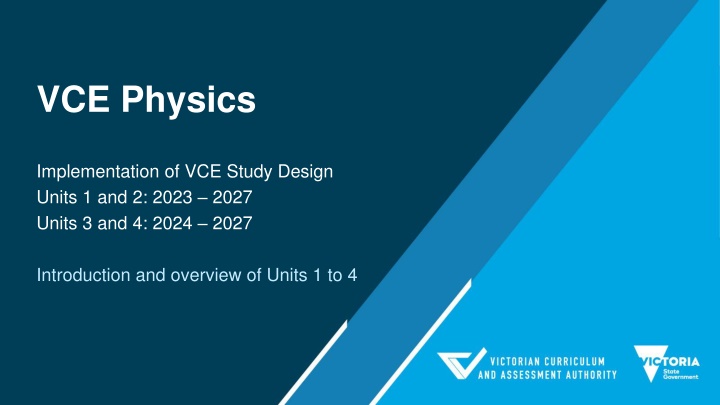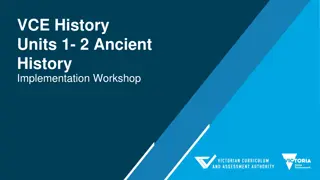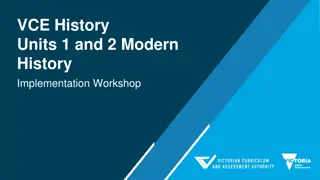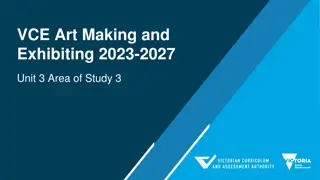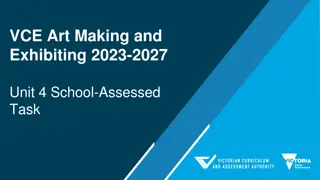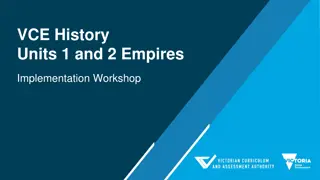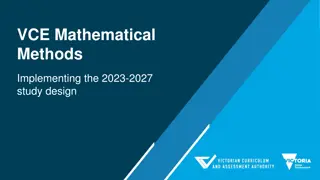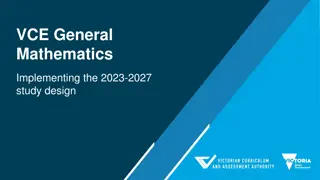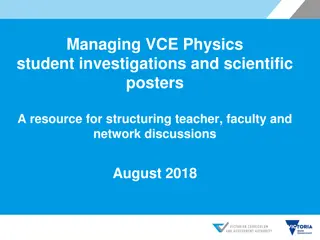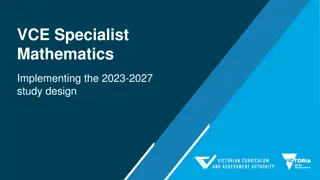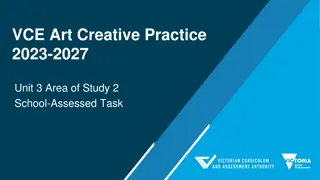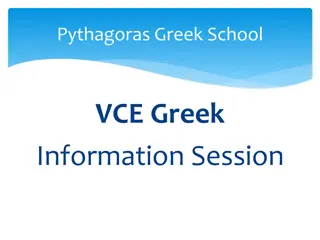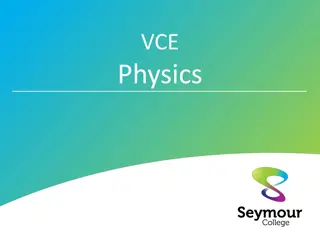VCE Physics Study Design 2023-2027: Overview of Key Science Skills and Changes
Explore the revised VCE Physics study design for 2023-2027, focusing on key changes such as the introduction of eight scientific methodologies, the shift from "reliability" to "repeatability and reproducibility," extrapolation techniques, constructing linearised graphs, identifying outliers, distinguishing between opinion and evidence, and considering non-scientific factors in physics-related societal issues.
Download Presentation

Please find below an Image/Link to download the presentation.
The content on the website is provided AS IS for your information and personal use only. It may not be sold, licensed, or shared on other websites without obtaining consent from the author.If you encounter any issues during the download, it is possible that the publisher has removed the file from their server.
You are allowed to download the files provided on this website for personal or commercial use, subject to the condition that they are used lawfully. All files are the property of their respective owners.
The content on the website is provided AS IS for your information and personal use only. It may not be sold, licensed, or shared on other websites without obtaining consent from the author.
E N D
Presentation Transcript
VCE Physics Implementation of VCE Study Design Units 1 and 2: 2023 2027 Units 3 and 4: 2024 2027 Introduction and overview of Units 1 to 4
Purpose Outline implementation support resources Explain the key requirements and major changes of the revised study design Consider VCE assessment principles in relation to assessment
VCE resources VCE Physics Study Design 2023-2027 VCE and VCAL Administrative Handbook
New study design support materials: updated webpages https://www.vcaa.vic.edu.au/curriculum/vce/vce-study-designs/physics/Pages/Index.aspx VCE Physics Study Design 2023-2027 (staged implementation) VCE Physics support materials: planning advice; teaching and learning activities and plans; assessment advice VCE examination specifications 2024-2027 VCE sample examination (available end of 2023) Implementation videos: Introduction; Units 1&2; Units 3&4 Live Q&A sessions in 2022 for Units 1&2 Live Q&A sessions in 2023 for Units 3&4, with a special focus on assessment
Staged implementation Units 1 & 2: 2023 2027 Units 3 & 4: 2024 2027
VCE Physics 2023-2027 Structure Scope of study, Rationale, Aims Cross-study specifications Characteristics of this study Terms used in this study Assessment 11 Areas of Study Key Knowledge (and relevant Key Science Skills) 4 1. Satisfactory completion- certification 2. Levels of achievement Units
Overview of changes key science skills Eight scientific methodologies (p 13 of the study design) Reliability replaced with repeatability and reproducibility Extrapolate to determine graph intercepts of significance Construct linearised graphs and identify intercepts of significance Error bars constructed from provided information e.g., 25 2 m sec-2 Identify outliers, and contradictory, provisional or incomplete data Distinguish between opinion and evidence, and scientific and non-scientific ideas Consideration of non-scientific factors related to analysis and evaluation of physics-related societal issues: social; economic; legal; and political
Overview of changes new inclusions Cross study specifications: - New sections: critical and creative thinking; ethical understanding; individual and collaborative scientific endeavour; Aboriginal and Torres Strait Islander knowledge, culture and perspectives Characteristics of the study: - Use of verbs in key knowledge cognitive triangle - Treatment of data: tables and graphs Terms used in this study: - Terms for force - New sections: measurement terms; measurement errors, uncertainty, significant figures and outliers
Overview of changes Units 1 to 4 Streamlining of content: - Unit 1 reduced, including origins of atoms , particle physics and some thermodynamics/climate science reconfigured as options - Significant electromagnetic radiation from Unit 4 moved to Unit 1 - Unit 2 options increased in number but decreased in scope - Increased cohesion of relativity placed in Unit 4 to link with light and matter Units 1 and 2 assessment 16 suggested tasks (others are possible) Units 3 and 4 assessment reduced to 5 mandated SAC tasks
Aims of VCE Physics (p 7 of study design) Two specific aims for the study: apply physics models, theories and concepts to describe, explain, analyse and make predictions about diverse physical phenomena understand and use the language and methodologies of physics to solve qualitative and quantitative problems in familiar and unfamiliar contexts
Develop aim and questions, formulate hypotheses and make predictions Key Science Skills (p 11&12) Analyse, evaluate and communicate scientific ideas Plan and conduct investigations Contextualised for VCE Physics Progressively higher demonstration of skill across Units 1 to 4 May focus on a specific skill, or a progression of skills in the context of an investigation Deploy in different contexts Key Science Skills Construct evidence- based arguments and draw conclusions Comply with safety and ethical guidelines Analyse and evaluate data and investigation methods Generate, collate and record data
Integration of key knowledge and key science skills Key science skills: are not an add on to the key knowledge may be explicit in key knowledge may be implicit, allowing flexibility for teachers to choose when/how to include in teaching and learning programs Key science skill Construct linearised graphs and identify the significance of the gradient (using relationships relevant to the ley knowledge outlined in the areas of study Key knowledge examples of the inclusion of key science skills Unit 1 Area of Study 1 Calculate the wavelength, frequency, period and speed of waves using Unit 1 Area of Study 3 Investigate and apply theoretically and practically concepts of current, resistance, potential difference Unit 2 Area of Study 1 Analyse graphically, numerically and algebraically, straight-line motion under constant acceleration Unit 3 Area of Study 1 Investigate and apply theoretically and practically the concept of work done by a force
Key science skills planners A planner for mapping Units 1 and 2 key science skills Note: a separate planner is available for Units 3 and 4
Scientific Investigation (p 13 15): asking questions; testing ideas; using evidence Opportunities for teacher-facilitated, student-adapted and student-designed investigations across Units 1 4 Scientific investigation methodologies for 2023-2027 Study Design: Case study Classification and identification Experiment Fieldwork Literature review Modelling Product, process or system development Simulation
Examples of scientific methodologies Methodology Example Case study The monkey and the hunter problem Classification and identification selected elements Experiment Investigate the nature of friction forces between two surfaces Fieldwork Use a spectrometer to observe star light Literature review Explain how a Geiger counter works Modelling Make a model of a fuse Product, process or system development focus Simulation Investigate collisions between objects Refer to the Support materials on the VCAA website. Compare emission and absorption spectra for Learning materials have been tagged with relevant methodology Develop a fluid lens system with an adjustable
Practical work Central component of learning and assessment Includes activities and investigations such as laboratory experiments, fieldwork, simulations, modelling and other direct experiences described in the scientific investigation methodologies Increased time allocated to practical work: A minimum of 15 hours for student practical work across Unit 1 and Unit 3 (approx. 5 hours for each area of study) A minimum of 10 hours for student practical work in Unit 2, Areas of Study 1 and 2 A minimum of 5 hours for student practical work across Unit 4, Area of Study 1 A minimum of 7 hours for the student investigation Unit 2, Area of Study 3 A minimum of 10 hours for the student-designed investigation in Unit 4, Area of Study 2.
Logbooks (p 14) Logbook of practical activities maintained for each of Units 1 to 4 for recording, authentication and assessment purposes. The presentation format of the logbook is a school decision and no specific format is prescribed. Its purposes may include: reporting on an investigation or activity responding to questions in a practical worksheet or problem-solving exercise writing up an investigation as a formal report or as the basis of a scientific poster providing a basis for further learning, for example, referenced in class discussions about demonstrations, activities or practical work
Formula sheet The current formula sheet for the external examination will be reviewed along with the examination specifications and will be published in December 2023, after the 2023 VCE Physics examination has been sat by students Students should be encouraged to become familiar with the formula sheet as part of their regular classes Development of students A3 pre-written notes for the external examination has been strongly supported by VCE Physics teachers
Units 1 and 2 Structure Unit titles Area of Study titles Unit 1: How is energy useful to society? Area of Study 1: How are light and heat explained? Area of Study 2: How is energy form the nucleus utilised? Area of Study 3: How can electricity be used to transfer energy? Unit 2: How does physics help us to understand the world? Area of Study 1: How is motion understood? Area of Study 2: How does physics inform contemporary issues and applications in society (18 options)? Area of Study 3: How do physicists investigate questions?
Integrating Unit 2 options into Units 1 and 2 core Content in the Unit 2 Area of Study 1 options may be used to support learning in Units 1 and 2 and to provide students with ideas for further investigation, for example: Unit 2 Area of study 2 option 2.1 How does physics explain climate change? Application Unit 1 AoS1: Comparison of the total energy across the electromagnetic spectrum emitted by objects at different temperatures Unit 1 AoS1: Sound as the transmission of energy via longitudinal pressure waves Unit 1 AoS2: Relationship between properties of , and radiation and their uses in medical applications Unit 1 AoS3: Transformers, diodes, capacitors, heat and light sensors Unit 2 AoS1: Suitability of different materials for use in structures Unit 2 AoS1: Calculation of stress and strain for bone and muscle 2.10 How do instruments make music? 2.6 How is radiation used to maintain human health? 2.12 How can AC electricity charge a DC device? 2.4 How do forces act on the human body? 2.5 How do forces act on the human body?
Units 3 and 4 Structure Unit titles Unit 3: How do fields explain motion and electricity? Area of Study titles Area of Study 1: How do physicists explain motion in two dimensions? Area of Study 2: How do things move without contact? Area of Study 3: How are fields used in electricity generation? Unit 4: How have creative ideas and investigation revolutionised thinking? Area of Study 1: How has understanding about the physical world changed? Area of Study 2: How is scientific inquiry used to investigate fields, motion or light?
Curriculum and assessment programs Each school is different: - different contexts in which students operate - different circumstances in which schools are situated Students will have different: - strengths and talents - available resources Schools have flexibility in: - designing curriculum programs that meet the needs of their cohort and the context in which they are learning - developing assessment programs that are aligned to the VCE Physics Study Design and comply with VCE assessment principles.
Planning template Whilst designed specifically for schools seeking to deliver a VCE study for the first time, the VCE Curriculum and Assessment Plans are a useful tool for all teachers in planning assessment.
Units 1-4 School-based Assessment Two forms of assessment for each outcome: Satisfactory completion of an outcome (S or N) - Units 1-4 Levels of achievement - school-based in Units 1 and 2 - School-assessed Coursework (SAC) moderated against external examination in Units 3 and 4
Integrity and Authentication The integrity of VCE Assessments is of a paramount concern to maintain the integrity of the VCE qualification: - teachers and schools need to develop and implement robust authentication strategies to ensure that the student s submitted work is clearly their own - For VCE Physics most assessments are conducted under test conditions Effective schools will build a culture of integrity and trust underpinned by teaching and learning practices of ongoing formative assessment to gather knowledge and evidence of student abilities and achievement.
VCE assessment principles The VCE Assessment Principles state that assessment should be: valid and reasonable equitable balanced efficient
VCE Assessment principles Valid Equitable fair and reasonable designated task type conducted under fair conditions for all students clear instructions included accessible to all students doesn t privilege or disadvantage certain groups of students alternative tasks (if set) are comparable in scope and demand
VCE Assessment principles Efficient minimum number of assessments precision vs efficiency minimise undue workload/stress on students part of the regular teaching and learning program avoid under or over assessment of the outcome completed mainly in class and within a limited timeframe Balanced variety of task types used variety of conditions used allow students to demonstrate different levels of achievement suitable criteria, descriptors, rubrics or marking schemes used representative parts of outcomes, key knowledge and key skills are assessed
Units 1 and 2 Assessment Underpinned by VCE Assessment Principles All assessments at Units 1 and 2 are school-based, including procedures for assessment of levels of achievement List of 16 selected tasks for Unit 1 Outcomes 1, 2 and 3 (p 28) List of 16 selected tasks for Unit 2 Outcomes 1 and 2 (p 49) If multiple tasks are selected for Unit 1 Outcomes 1, 2 and/or 3, or Unit 2 Outcomes 1 and/or 2, they must be different Same task cannot be selected more than once across Outcomes 1 and 2 Unit 2 Outcome 3: A report of a practical investigation (student-designed or student-adapted) using an appropriate format, for example, a scientific poster, practical report, oral communication or digital presentation.
Examples of Units 1 and 2 assessment tasks The Support materials on the VCE Physics study page include 10 examples of assessment tasks and their management: Assessment task type Comparison of two scientific models Unit and AoS Unit 1 AoS1 Unit 1 AoS3 Unit 1 AoS1 Contexts Models of refraction: Newton & Huygens Models of electric current in a circuit Design a thermos Design, build, test and evaluate a device Media analysis Unit 1 AoS1 Unit 1 AoS2 Unit 1 AoS1 Unit 1 AoS1 Light pollution; magma power Nuclear power Analysis of provided data from a climate model Stations: Thermal physics & waves and light Real-world physics applications Reflective annotations of practical activities Report of a laboratory activity Unit 2 AoS1 Newton s second law of motion
Units 3 and 4 Assessment Unit 3 School-assessed Coursework: 30 per cent of study score Unit 4 School-assessed Coursework: 20 per cent of study score End-of-year examination: 50 per cent of study score For Unit 3 Outcomes 1, 2 and 3 and Unit 4 Outcome 1: Four designated School-assessed Coursework tasks. Each task can only be selected once across Units 3 and 4. For each task the time allocated should be approximately 50 minutes for a written and 5 minutes for a multimodal or oral presentation For Unit 4 Outcome 2: communication of the design, analysis and findings of a student-designed and student-conducted scientific investigation through a structured scientific poster and logbook entries
Revised Units 3 and 4 VCE Physics Assessment School-based Assessment tasks: Unit 3 Outcomes 1, 2 and 3 & Unit 4 Outcome 1 Outcome Assessment tasks Unit 3 Outcome 1 2-D motion device, design or innovation analysis and evaluation of primary and/or secondary data, including data plotting, identified assumptions or data limitations, and conclusions problem-solving, applying physics concepts and skills to real-world contexts comparison and evaluation of two solutions to a problem, two explanations of a physics phenomenon or concept, or two methods and/or findings from practical activities Changed ideas application of physics concepts to explain a model, theory, Unit 3 Outcome 2 Field models Unit 3 Outcome 3 Electricity generation Unit 4 Outcome 1
Examples of SAC task allocations across Units 3 and 4 Assessment task Teacher 1 Unit 3 Area of Study 2: Application of physics concepts to the operation of devices and innovations including: geostationary satellites; motors; microphones; loudspeakers; and particle accelerators. Unit 4 Area of Study 1: Analysis and evaluation of data obtained from experiments that investigate the nature of light and matter, specifically: the photoelectric effect, interference patterns; and absorption and emission spectra. Unit 3 Area of Study 3: Application of physics concepts to the real-world context of electricity generation and distribution in Victoria. Teacher 2 Application of physics concepts to explain a model, theory, device, design or innovation Unit 4 Area of Study 1: Evaluate the evolution of physics understanding of light and matter through the application of wave and particle models to historic experimental results Analysis and evaluation of primary and/or secondary data, including data plotting, identified assumptions or data limitations, and conclusions Unit 3 Area of Study 3: Analysis a data base for the effect of length and resistance of power lines on power delivery with and without the use of transformers. Problem-solving, applying physics concepts and skills to real-world contexts Unit 3 Area of Study 1: Analyse and evaluate a case study of a video of a current sport event involving projectile motion to determine a value of acceleration due to gravity. Comparison and evaluation of two solutions to a problem, two explanations of a physics phenomenon or concept, or two methods and/or findings from practical activities Unit 3 Area of Study 1: Analysis of the motion of projectiles using both constant acceleration equations and conservation of energy, including consideration of the effects of air resistance. Unit 3 Area of Study 2: Compare the nature of Earth s gravitational and magnetic fields in terms of nature (static or changing, and as uniform or non- uniform) shape, direction and strength.
New Unit 4 Outcome 2 Scientific poster format Maximum: 600 words 20 25% of space allocated to communicating main finding Title as an investigation question Student name Introduction Discussion Communication statement reporting the key finding of the investigation in response to the investigation question as a one-sentence summary Methodology and methods Results Conclusion References and acknowledgments
VCE Physics scientific poster example Unit 1 Area of study 1 How does road surface colour affect heat absorption? Stu Dent Introduction more heat than brown or white surfaces, having implications for choice of colour for road surfaces in Discussion Black surfaces absorb Methodology and methods response to climate change Conclusion Results References and acknowledgments
VCE resources Support materials on the VCAA study pages for VCE Physics Administrative information for School-based Assessment VCAA Bulletin and Notices to schools Statistical moderation reports School-based assessment audit reports School-based assessment coursework reports Examination reports School calendar and assessment policy The school teaching and learning program Subscribe to VCAA notifications:
Contact Maria James Curriculum Manager, Science 03 9059 5148 Maria.James2@education.vic.gov.au
